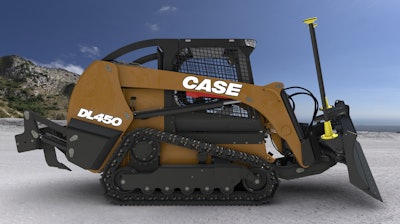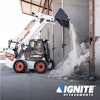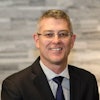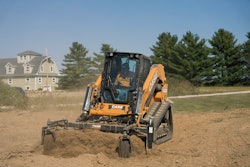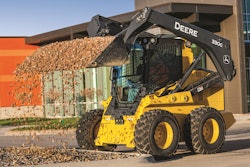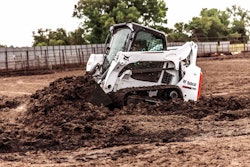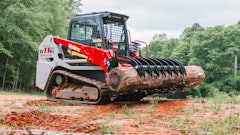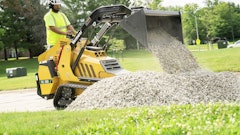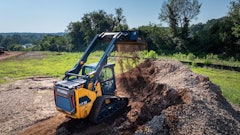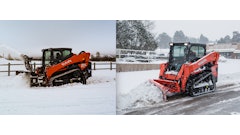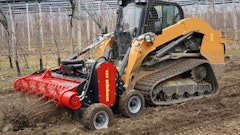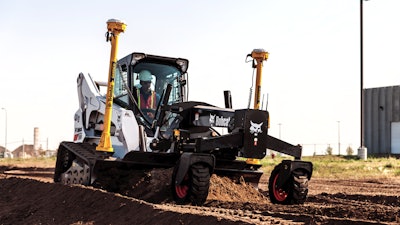
Compact track loaders (CTLs) are encroaching on territory usually reserved for dedicated small wheel loaders and finish dozers with the lure of increased attachment versatility. But the question remains: just how large can a CTL get and still offer the benefits of a compact machine?
“The real limits on how large you can design a CTL are set by customer application requirements,” says Brian Rabe, senior product manager, skid and track loaders, Gehl. “Applications determine the specifications.”
He cites the new Gehl VT320 as an example. Introduced at CONEXPO-CON/AGG, it has a rated operating capacity (ROC) of 3,200 lbs. at 35% tipping load (4,571 lbs. at 50% tipping load) and offers 114 gross hp, but still has a very compact footprint and operating weight to accommodate trailer, jobsite and application requirements.
“The goal is to efficiently utilize the high-performance aspects of the machine, not the physical size or capacity,” Rabe explains. “Building a physically larger machine can create other issues such as height and turning access, higher ground pressure and weight restrictions.”
Large CTLs More Popular
John Deere classifies large CTLs as models with an ROC of 2,600 lbs. and up. The popularity of this size class continues to rise.
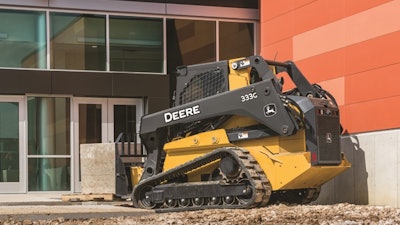 A good track loader would not have more than 6 psi ground pressure and ideally you would want to be closer to 5 psi ground pressure and under to make a good machine that is not going to sink in soft, muddy conditions. For the largest compact track loaders achieving these low ground pressures is possible by putting more track on the ground.
A good track loader would not have more than 6 psi ground pressure and ideally you would want to be closer to 5 psi ground pressure and under to make a good machine that is not going to sink in soft, muddy conditions. For the largest compact track loaders achieving these low ground pressures is possible by putting more track on the ground.
“The CTL market has seen consistent growth in the last three years,” adds John Dotto, brand marketing manager for Case Construction Equipment. “We continue to see growth in landscaping, agriculture, utility and especially in new residential construction applications as contractors realize the benefits of the larger, more powerful CTLs. Any application where contractors are primarily running on unimproved surfaces in a high-production environment makes sense for a larger [model].”
But there are limitations. “CTLs are growing both in size and capability, but they still need to fit the practical application of being a piece of compact equipment,” says Jason Archbold, marketing manager, Bobcat Company. “The purpose of compact equipment is to be able to easily move it from jobsite to jobsite and move around and work in tight spaces. Any larger and those aspects become compromised. Also, if CTLs get any larger, they become comparable to smaller pieces of heavy equipment like smaller dozers and wheel loaders.
“The size of the loader desired will always be dictated by the tasks that are being performed on the jobsite,” he continues. “Landscapers moving between homes in residential areas might want smaller machines so they can move within those tighter spaces. A different landscaper who works more on hardscape projects might prefer a larger machine as he may be lifting and carrying heavier objects.”
It’s all about the capability to complete the task. “Machine size is not necessarily driven by the application but by the tasks performed within that application,” Archbold points out. “If the operator is spending a significant portion of the day grading large amounts of dirt or lifting heavy materials, then a larger compact track loader will be desired.”
Large CTLs also meet a specific price point for contractors who may not be able to justify the leap to larger equipment. “They are definitely less expensive than the next biggest piece of equipment, like a small crawler dozer or maybe a wheel loader,” says Zupancic.
Towing Restrictions Depend on Size
Weight is a key consideration with large CTLs. “It depends on the state, but under 15,000 lbs. is kind of a threshold of total trailer weight with the machine,” says Zupancic. “Above that, you need a CDL.” While that is not an issue for some customers, it is for others. “I have seen some of these track loaders that weigh close to 14,000 lbs. by themselves. That would leave you no room for the weight of the trailer.”
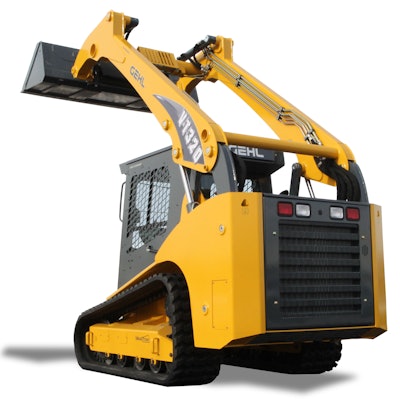 Both the Gehl VT320 and Mustang 3200VT have ROCs of 3,200 lbs. at 35% tipping load and produce 114 gross hp. Yet, their compact footprint and operating weights allow them to accommodate most trailering and jobsite requirements.
Both the Gehl VT320 and Mustang 3200VT have ROCs of 3,200 lbs. at 35% tipping load and produce 114 gross hp. Yet, their compact footprint and operating weights allow them to accommodate most trailering and jobsite requirements.
First, carefully assess the weight and dimensions of the CTL. “If the machine is too large for the trailer, then the owner must either consider purchasing another trailer or finding a CTL that will fit what he/she already owns,” says Archbold. “Second, the vehicle pulling the loader and trailer must have the capacity to pull the weight behind it. Lastly, an owner must consider their skill level in pulling heavier pieces of equipment and the limitations of their license.”
Width of the trailer is also an important consideration. “As machines increase in capacity, they also get wider to provide stability,” says Dotto. “Set yourself up for success by making sure you’ve properly sized your trailer to the loader.”
Design Considerations
As CTLs grow in size and power, the design of the machine itself has to adapt. For instance, cooling a high horsepower engine and hydraulic system becomes more of a challenge.
“With the general frame structure of a CTL, it would seem that, with current technology, anything above that 120-hp threshold would not be able to operate without some sort of external cooling,” notes Dotto. “Keeping that hydraulic system cooled would become an engineering challenge.”
Larger track loaders also come with increased operating costs. “Tracks get expensive; there is a lot of rubber,” says Zupancic. Due to the increased weight and power generated by large CTLs, they will wear the rubber tracks more rapidly. “We do see longer life characteristics on the lighter machines than we do on the heavier machines.”
Track systems also have to be engineered to maintain acceptable ground pressure. “A good track loader would not have more than 6-psi ground pressure and ideally you would want to be closer to 5 psi and under to make a good machine that is not going to sink in soft, muddy conditions,” says Zupancic.
For the largest CTLs, achieving these low ground pressures is achieved by putting more track on the ground. “Manufacturers can offset some of the ground pressure by making the track systems longer or wider,” says Zupancic. However, there is a caveat. “You can only go so wide because the largest track loaders have to fit on a standard trailer. As you get wider — total machine width that is wider than 82 in. — you are not going to be able to get the tracks between the wheel wells on a standard trailer.”
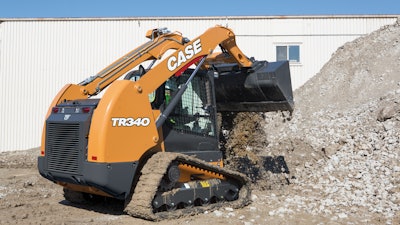 The Case TV380 is a 10,500-lb. machine with 17.7-in. tracks that enable a ground pressure of only 4.4 psi.
The Case TV380 is a 10,500-lb. machine with 17.7-in. tracks that enable a ground pressure of only 4.4 psi.
So larger does not necessarily mean more ground pressure. “Looking at our machines’ specs, the ground pressure actually goes down as you get into the larger models because the wider track widths spread out the weight of the machine,” says Dotto. “The Case TV380, a 10,500-lb. machine, has 17.7-in. tracks and a ground pressure of only 4.4 psi.”
Trade-offs of Operating Cost vs. Performance
CTL growth has passed most people’s expectations. “The CTL industry is still growing really strong and it has overtaken skid-steer sales,” says Zupancic. “We have seen growth into all of the segments, even in places where you don’t think a track loader would typically fit the customer needs very well.”
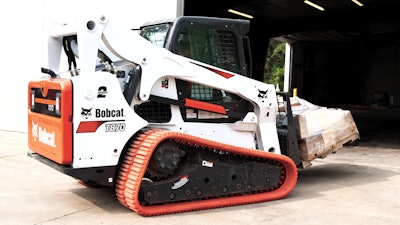
Yet, customers are purchasing track loaders for these applications. “You see them on highways. There are a lot of track loaders that are doing road work,” says Zupancic.
“Contractors know they cost more to maintain because of the undercarriage than a skid steer,” he continues. “But they are fine with those trade-offs because [CTLs] have the added productivity of being able to push more and lift more since they weigh more due to the undercarriage; the ability to keep that machine from tipping forward; and [the ability] to work in mud where a skid steer would struggle after a rainstorm. They are buying track loaders to an extent that I never anticipated even as few as three years ago.”
Versatility vs. Dozing Performance
Often, contractors choose large CTLs instead of smaller finish dozers because of the versatility of running numerous attachments. “When you are not doing finish grade work 100% of the time, you can put a different attachment on it and make that a whole new machine form,” says Zupancic.
Archbold agrees, noting, “Contractors are learning that the performance delivered by a larger CTL is similar to a smaller dozer. With the similar performance and attachment versatility, CTLs deliver a higher value as they may simply deliver a greater level of utilization. Also, having rubber tracks makes compact track loaders able to move across many more surface types than a typical small dozer.”
Transportability can also favor a CTL assuming the weight does not necessitate a CDL.
Such advantages have helped expand the CTL market. “As CTLs have gotten larger, they have started to take a small amount of market share from small wheel loaders and dozers. But the truth is that a dozer is a dedicated machine, built from the ground up to do one task,” says Dotto. “A CTL is a versatile, high-production machine made for a variety of tasks.”
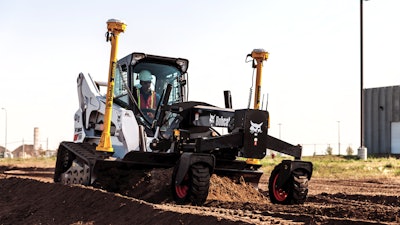 Compact Track Loaders (CTLs) are encroaching on territory usually reserved for dedicated small wheel loaders and finish dozers, with the lure of increased attachment versatility.
Compact Track Loaders (CTLs) are encroaching on territory usually reserved for dedicated small wheel loaders and finish dozers, with the lure of increased attachment versatility.
“Initial investment on a large CTL and six-way dozer blade is comparable to a small dozer,” he acknowledges. “But the versatility of the track loader can make a big difference to the bottom line.”
Nevertheless, large CTLs will never replace dedicated finish dozers. “If you are a finish grader and that’s your company, a dozer is probably going to be a better solution because it is purpose built and it is specific to that application,” says Zupancic. “Dozers are built for doing a lot of grading and dozing and being more precise. They have advantages in that the blade is positioned and mounted right to the C-frame of the machine itself.”
With the CTL, the pushing point is much higher on the machine. “Skid steers and track loaders have a lot of linkage and the pushing loads on that blade can transfer through all of that linkage and pivot points,” Zupancic explains. “A dozer has quite a bit less linkage and it is mounted very low on the machine. That gives you some advantages in terms of angles, preciseness and adjustability of the blade — smaller increments of adjustment.”
Dozers are also usually heavier, which makes them better suited for pushing larger amounts of materials.
Dedicated vs. Value-based Purchasing
There are two types of CTL customers: those focused on a dedicated machine that can provide the highest performance, and those seeking a value-based replacement for their skid steer.
“Dedicated RT/VT track loader customers are purchasing machines for the very high performance, standard features, larger operator station space, improved operation balance and superior durability,” says Rabe. “Customers purchasing the new ‘Skid Loader on Tracks (SLOT)’ RT165 model are typically looking for a value-based replacement for their familiar wheeled skid-steer unit to allow jobsite access [earlier in the season], lower ground pressure, higher travel speeds and good performance. We absolutely feel there are markets for both types of equipment.”
Yet, CTLs have evolved to be more than tracked versions of an existing skid-steer loader. “Some of the largest CTLs on the market — with rated capacities at 4,000 lbs. and beyond — are already without an equivalent skid-steer counterpart,” says Dotto.

